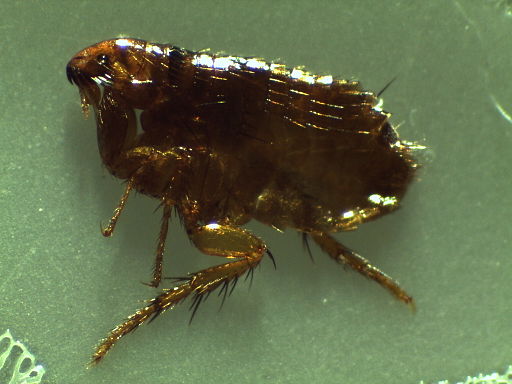Fleas
How To Identify Fleas
Fleas are tiny beetles, about 2.5 mm long. They have flat bodies and are wingless creatures. Their color varies from brownish-black to black, but reddish black when full of blood. Fleas are covered with varying markings and colorations. They have piercing mouth parts and they jump from one place to another to reach their host. Most fleas can jump up to 8 inches. Their larvae are white, slender, eyeless, and legless. The life cycle of fleas is about 100 days. There are many species of fleas in the United States, most common being the cat flea and blue-black flea.
Fleas Eating And Feeding Habits
Fleas live in hot, dry conditions. Because they can jump quite high, they easily hitch on shoes, socks, trousers, or blankets. Fleas are parasites that survive on warm-blooded blood of humans and animals like cats, dogs, rats, opossums, etc.
Larvae feed on organic debris like feces of adult fleas, which contain undigested blood. Flea beetle larvae feed on roots of many plants. Adult fleas rest in the soil and on garden debris in winter months and emerge in early spring.
Threats
Fleas can prove to be very harmful to humans and the fauna and flora. Flea bites on humans cause painful, itchy red bumps. They can also spread diseases such as typhus and tularemia. Fleas are also known to be the most common carriers of rare bubonic plague and can transmit murine typhus, a bacterial disease, to human beings through infected rats.
In cats, dogs and humans, fleas can cause allergies. Pet with flea bites usually scratch themselves. Flea saliva can result in serious allergy dermatitis in pets. Fleas also transmit tapeworms in pets and cause anemia. In plants and vegetables, fleas can cause early blight and bacterial wilt. They can also damage crops by chewing tiny holes in leaves. Seedlings are most susceptible to damage by fleas.
How To Prevent Fleas In Home
If you find any sign of fleas in your yard, home or office, immediately Contact Crown Pest Control for the best flea elimination treatment. Our specialists are adept at recognizing the species involved, the severity of the problem, and any potential threats. Our professionals will visit your premises and take the time to inspect the critical areas and common habitats. Accordingly, they use the most advanced and the most-effective treatment to make your home, office and surroundings pest-free.
Some DIY Tips To Get Rid Of Fleas
- Eliminate plant debris in winter and keep gardens moist in summers.
- Cultivate soil at regular intervals.
- Keep yards clean and free of pet droppings.
- Remove all articles from under the beds, on carpets and from under furniture.
- Clean and vacuum the areas under carpets, on the foot of furniture, wall-floor junctions, etc.
- Clean areas frequented by cats, e.g. tabletops, counters, etc.
- Give regular baths to your pets and give them a monthly flea and tick treatment.
- In addition to the above steps, Crown Pest Control will administer proper treatment to prevent any flea incursions.
Services Areas
Crown Pest Control is a reputable pest control company and we provide pest treatment services in Greater Charlotte Metropolitan Area, NC, i.e. Matthews, Mount Holly, Indian Trail, Monroe, Waxhaw, Concord, Harrisburg, Huntersville, Fort Mill (SC), Indian Land (SC), Tega Cay (SC), Pineville, Mineral Springs, Mint Hill, Stallings, Dilworth, Ballantyne, Cornelius, Davidson in North Carolina.

